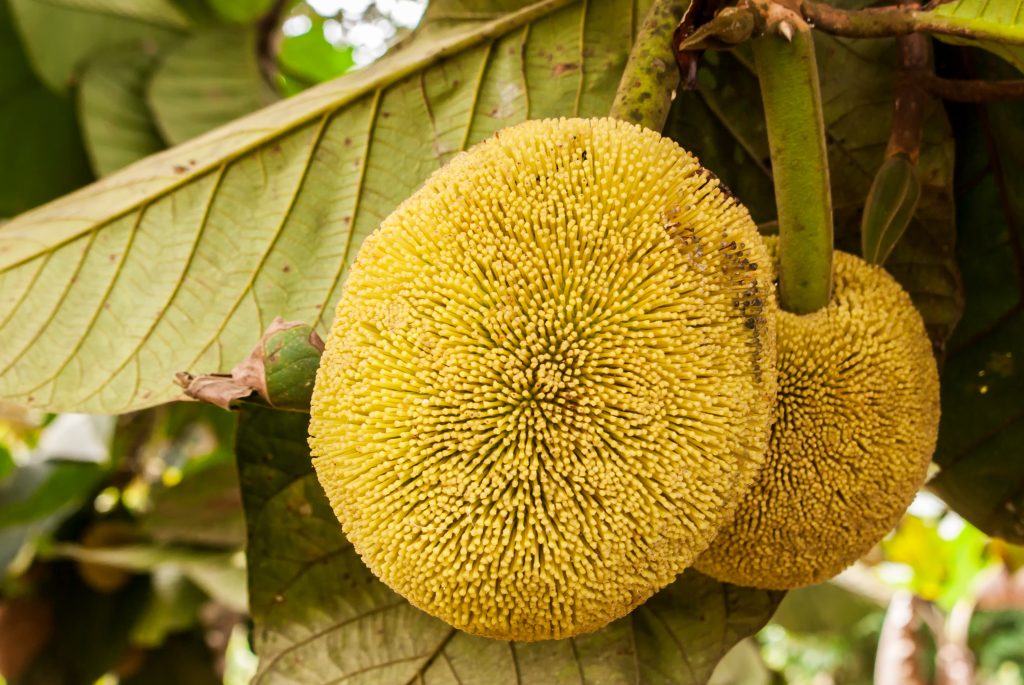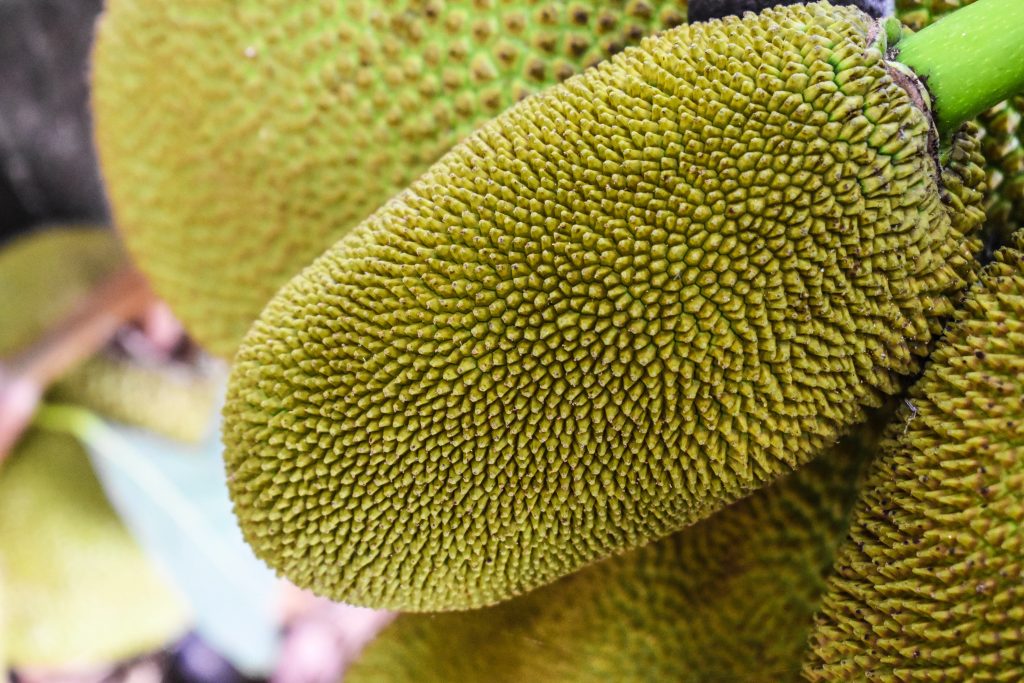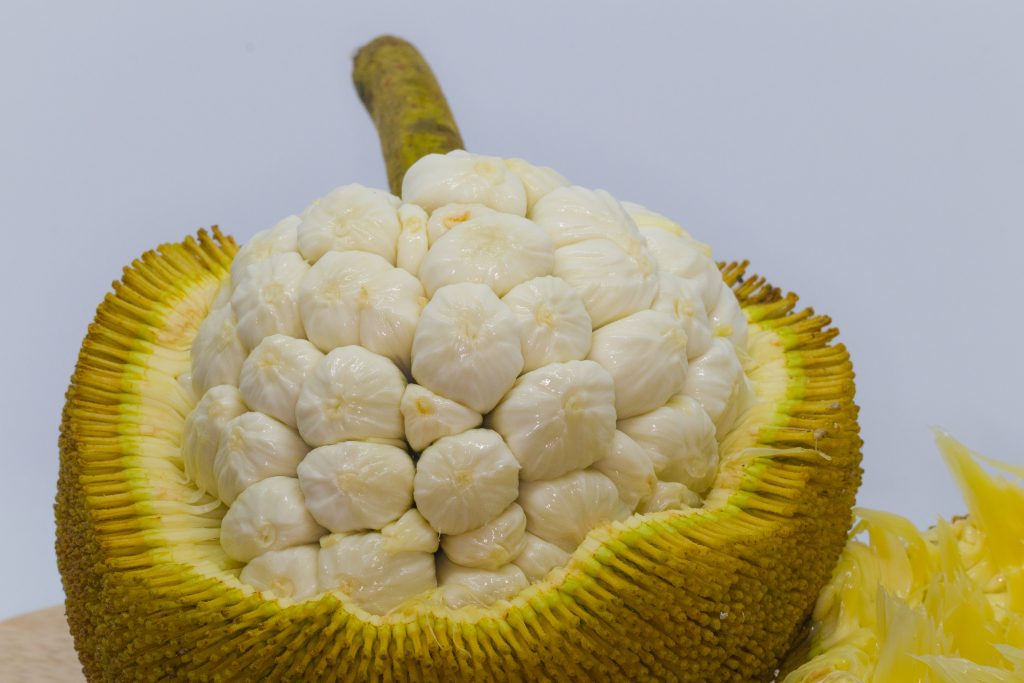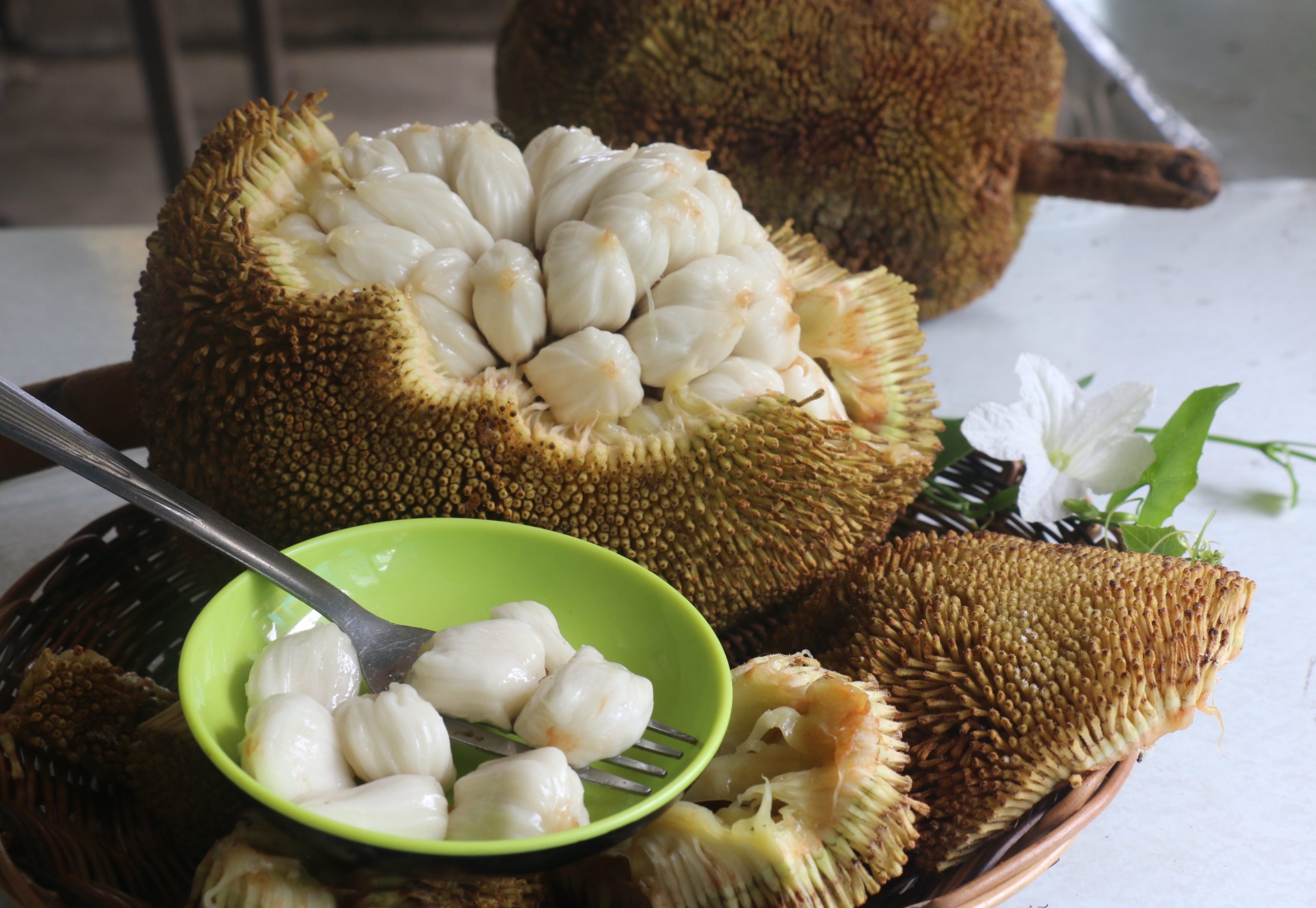Marang is a tropical fruit popular in Southeast Asia, particularly in the Philippines. It has a spiky, green exterior with creamy, white flesh inside that is both pungent and sweet. The fruit is highly regarded for its unique flavor, aroma, and numerous health benefits, making it a sought-after delicacy in many parts of the world.
Table of Contents
What is a Marang?
Marang (Artocarpus odoratissimus) is a tropical fruit that belongs to the same family (Moraceae) as jackfruit, breadfruit, and cempedak. It is also known by other common names such as johey oak, madang, tarap, and terap.
This fruit tree is an evergreen tree native to Borneo, Palawan, Mindanao Island, and the Philippines, but it is also grown in other Southeast Asian countries, such as Malaysia, Indonesia, and Thailand.
Marang is a medium-sized fruit weighing up to 2 kg (4.4 lbs). The rind is covered in green spikes and has a bumpy texture. When ripe, the spikes soften, and the fruit turns yellowish-brown.
The fruit is comprised of multiple segments, each containing a creamy, white flesh surrounding a seed. The flesh has a texture similar to custard and is highly aromatic.
In terms of flavor, marang has a unique and complex taste. It is often described as a combination of various flavors, such as banana, pineapple, papaya, and jackfruit. The fruit is sweet and has a slightly tangy and acidic taste. The aroma of marang is also very distinct, with a solid and sweet scent often compared to a mix of caramel and durian.
Marang is typically consumed fresh; the flesh can be eaten raw or used in desserts such as ice cream, cakes, and custards. The fruit is also used in traditional medicine for various ailments like coughs, diarrhea, and skin diseases. Additionally, the bark and leaves of the marang tree have been used for their medicinal properties.
The History of Marang
This tropical delicacy is a native of the picturesque Borneo Island, found explicitly in the pristine regions of Brunei, Kalimantan, Sabah, and Sarawak. While the fruit continues to thrive in its place of origin, it has also spread its wings and can now be found in other Southeast Asian countries such as Thailand and the Philippines.
The Marang’s popularity has grown, and it has now ventured into new territories, including Australia, Brazil, and various other tropical regions.
Marang has been used for its medicinal properties in traditional folk medicine for centuries. The roots of the marang plant are commonly consumed as a decoction by the Ibans in Sarawak to treat diarrhea.
Additionally, the ash from marang leaves can be applied topically to alleviate the pain and swelling caused by scorpion stings. Marang ash can also treat skin conditions such as scabies or kuris.
What Does a Marang Taste Like?
Marang is often compared to other exotic fruits such as durian and jackfruit but is considered more palatable by many due to its sweeter and less intense flavor.
The flesh of raw marang fruit is creamy and succulent, with a slightly fibrous texture. Its taste has often been described as sweet and aromatic, similar to a combination of banana and pineapple. It is sometimes compared to the custard apple due to its sweetness and creamy texture. Some people also detect a hint of durian flavor without the notorious smell associated with durian.
It’s less common to cook marang because the fruit loses its appealing flavor when heated. Most people prefer to consume marang fresh to enjoy its unique taste best. However, in some cultures, the seeds are boiled or roasted and eaten, which taste like a mild version of jackfruit seeds, with a nutty flavor and starchy texture.
How to Tell When Marang is Ripe
Here are some tips on telling when marang is ripe and selecting the best fruit when shopping for one.
Visual characteristics of ripe fruit:
- The texture of the fruit should be soft and slightly yielding to gentle pressure. A hard or rock-solid fruit indicates that it is not yet ripe.
- The fruit’s skin should be slightly rough and brown or yellow in color. An entirely green skin indicates that it is not yet ripe.
- The fruit should have a pleasant, sweet scent that is slightly musky.
Marang vs. Jackfruit vs. Durian



Marang, jackfruit, and durian are tropical fruits popular in Southeast Asia. While they have some similarities, they also have many differences.
Appearance: All three fruits are large and spiky, with a greenish-brown exterior. The marang and jackfruit have a round or oblong shape, while the durian is more oblong or football-shaped. Durian has more prominent thorns, but jackfruit has softer thorns. In comparison, marang has a spiky rind with sift thorns.
Texture: The texture of these fruits varies widely. The marang has a soft, custard-like texture, while the jackfruit has a fibrous texture similar to pulled pork. The durian is known for its creamy texture, which some people describe as similar to custard or cream cheese.
Taste: The taste of these fruits is also quite different. The marang has a sweet, fruity flavor with a hint of sourness. The jackfruit has a mild, fruity taste that some compare to a combination of pineapple and banana. On the other hand, durian has a strong, pungent odor and a rich, creamy flavor often described as an acquired taste.
Culinary uses: Marang and jackfruit are often eaten fresh, while durian is typically used in desserts and other dishes. Their flesh can make ice cream, smoothies, and other sweet treats. In some cultures, the seeds of jackfruit and durian are also roasted and eaten as a snack.
Cooking with Marang
Here’s a simple step-by-step guide on how to prepare and cook with marang:
- Start by washing the fruit under running water to remove dirt or debris.
- Cut off the stem and the bottom of the fruit.
- Using a sharp knife, make a shallow cut around the middle of the fruit.
- Pull the fruit apart with your hands, separating it into two halves.
- Remove the large seeds and discard them.
- Use a spoon to scoop the fruit’s flesh and set it aside.

Marang is a versatile fruit that can be used in various dishes. It is often eaten fresh but can also be cooked in sweet and savory dishes. Here are some popular ways to cook with marang:
Marang Steamed Bread: This bread is soft, fluffy, and delicately fragrant with a divine marang-infused aroma. A loaf of this, and you’ll forget the mundane wheat bread.
Marang Jam: This will be the new queen of the breakfast table. This sweet, tangy jam makes your toast feel like it’s on vacation in the Philippines. So just spread it, spoon it, and love it.
Crispy Tarap Fritters: Imagine the beautiful fusion of the marang’s tropical sweetness, lovingly hugged by a light, crispy, golden batter. It’s a fritter that’s had a glow-up.
How to Store Marang
Marang is a tropical fruit that can be stored using several methods to extend its shelf life. Here are some ways to keep marang:
Marang can be stored at room temperature for a few days. However, consuming it as soon as possible is best because the fruit can quickly spoil in warm temperatures.
Marang can be stored in the refrigerator for up to five days. Place the fruit in a plastic bag or an airtight container before storing it in the fridge.
Cut the fruit into small pieces, remove the seeds, and store them in an airtight container or freezer bag. Frozen marang can last up to six months in the freezer.
Marang can also be dried to extend its shelf life. Cut the fruit into small pieces and dry them in the sun or a dehydrator until completely dry. Store the dried fruit in an airtight container at room temperature.
Nutritional Benefits of Marang
Marang fruit is a natural way to improve your health and prevent illnesses. Adding marang fruit to your diet is an excellent way to enhance your overall health and ensure you get essential vitamins, minerals, and antioxidants.
This fruit has been used for centuries to treat different diseases and has many health benefits. One of the best things about marang fruit is that it’s low in calories and fat, so it’s an excellent snack for people who want to lose weight.
Marang fruit contains dietary fiber, vitamins, minerals, and antioxidants. Antioxidants are essential for reducing damage to your body caused by free radicals, which can contribute to chronic diseases like cancer and heart disease. Marang fruit contains powerful antioxidants like Vitamin C, carotenoids, and flavonoids, which can protect your body from damage.
Dietary fiber in marang fruit is crucial for maintaining a healthy digestive system and preventing constipation. It can also help to lower cholesterol levels and reduce the risk of heart disease.
Marang fruit is also an excellent source of essential vitamins and minerals like Vitamin B6, A, E, and Potassium. These nutrients are vital for maintaining healthy skin, hair, nails, and vision and controlling blood pressure.
Where to Purchase Marang
If you want to purchase marang, a specialty store with tropical fruits is the best place to start. Some larger supermarkets may also carry marang, depending on where you live.
You can find marang in Southeast Asia at local markets and fruit stands. The fruit is typically in season from late summer to early winter, with the peak season being from September to November.
It may be more challenging to find fresh marang outside of Southeast Asia. However, some specialty stores and online retailers may carry frozen or canned marang, which can be a good alternative. Remember that the quality and flavor of frozen or canned marang may not be as good as fresh marang.

